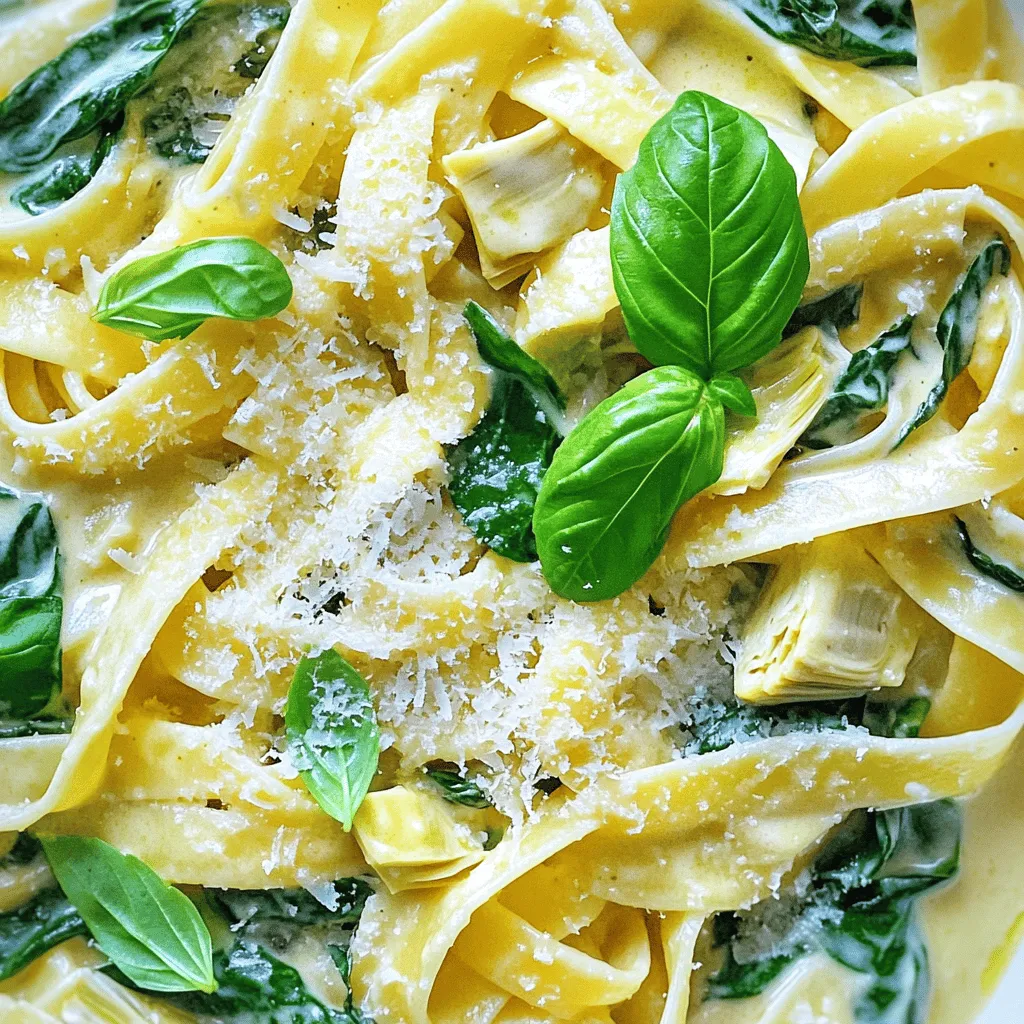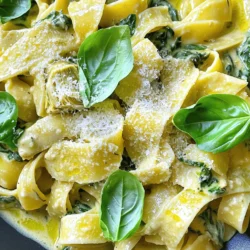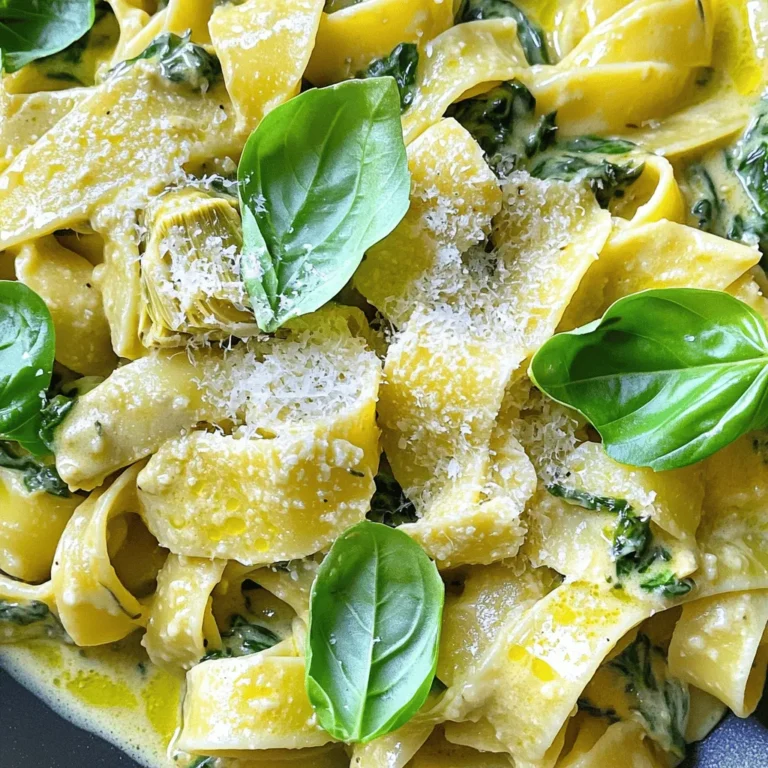If you’re craving a rich and flavorful dish that’s easy to make, you’ve come to the right place. Creamy Spinach Artichoke Pasta combines fresh veggies with a luscious sauce for a recipe you’ll love. Whether you’re cooking for yourself or impressing guests, this dish checks all the boxes. Join me as we dive into the steps, tips, and tricks to create this delightful meal that guarantees satisfaction in every bite!
Ingredients
List of Ingredients
To make creamy spinach artichoke pasta, you will need these simple ingredients:
– 8 oz fettuccine pasta
– 1 tablespoon extra virgin olive oil
– 2 cloves fresh garlic, minced
– 1 can (14 oz) artichoke hearts, drained and coarsely chopped
– 4 cups fresh baby spinach leaves
– 1 cup cream cheese, softened to room temperature
– 1 cup vegetable broth
– 1/2 cup freshly grated Parmesan cheese
– 1/4 teaspoon red pepper flakes (adjust to taste)
– Salt and freshly ground black pepper to taste
– A handful of fresh basil leaves, for garnish
Specific Cooking Tools Needed
To prepare this dish well, you will need these tools:
– Large pot for boiling pasta
– Skillet for sautéing
– Colander for draining pasta
– Mixing spoon for combining ingredients
– Measuring cups and spoons for accuracy
– Knife and cutting board for chopping
Tips for Choosing Fresh Ingredients
Choosing fresh ingredients makes a big difference. Here are some tips:
– Pasta: Select high-quality fettuccine for a better texture.
– Garlic: Look for firm, unblemished bulbs. Fresh garlic packs more flavor.
– Artichoke hearts: Choose canned ones packed in water, not oil.
– Spinach: Opt for vibrant, crisp leaves. Avoid any with yellow or wilted edges.
– Cream cheese: Use a full-fat version for richness.
– Parmesan cheese: Grate it fresh for the best taste. Pre-grated options can be dry.
– Basil: Fresh basil should smell fragrant. Avoid any brown or wilting leaves.
Using fresh ingredients enhances flavor and nutrition in your creamy spinach artichoke pasta.
Step-by-Step Instructions
Cooking the Pasta
First, bring a large pot of salted water to a boil. Add 8 oz of fettuccine pasta. Cook it for about 8 to 10 minutes until it’s al dente. Once done, drain the pasta but save 1/2 cup of the starchy water. This helps thicken your sauce later.
Sautéing the Garlic and Vegetables
In a big skillet, heat 1 tablespoon of extra virgin olive oil over medium heat. Then, add 2 cloves of minced garlic. Sauté the garlic for about 1 minute until it smells great and looks soft. Be careful not to burn it. After that, stir in the artichoke hearts from a 14 oz can. Cook them for 2 to 3 minutes. Next, add 4 cups of fresh baby spinach leaves. Stir gently until the spinach wilts, which should take about 2 minutes.
Making the Creamy Sauce
Now, lower the heat and add 1 cup of softened cream cheese. Stir it until it melts into the veggies. Slowly pour in 1 cup of vegetable broth, stirring all the while. This will make your sauce smooth and creamy.
Combining Ingredients
Gently toss in the cooked fettuccine to the creamy sauce. Make sure every piece of pasta gets coated well. If the sauce looks too thick, mix in some of that reserved pasta water until it’s just right.
Serving Suggestions
When serving, divide the creamy spinach artichoke pasta into bowls. Top with some freshly grated Parmesan cheese and a sprinkle of red pepper flakes for a kick. Don’t forget to add fresh basil leaves for color. This dish not only tastes great but also looks beautiful on the table.
Tips & Tricks
How to Achieve the Creamiest Texture
To make your creamy spinach artichoke pasta extra smooth, use softened cream cheese. It blends better than cold cream cheese. As you mix, you can add some reserved pasta water. This water has starch, which helps the sauce cling to the pasta. A little goes a long way, so add it slowly until you reach your desired creaminess.
Adjusting Flavor for Personal Preference
Each person loves different flavors. If you want more tang, add a bit of lemon juice or zest. For a bit of heat, increase the red pepper flakes. You can also try different cheeses, like feta or goat cheese, for unique taste. Taste your sauce as you go. This way, you can adjust the salt and pepper to fit your taste.
Common Mistakes to Avoid
One common mistake is overcooking the pasta. Cook it just until it’s al dente. This keeps it firm and helps it soak up the sauce. Another mistake is not stirring enough when adding the cream cheese. Stir well to avoid lumps. Lastly, don’t skip the reserved pasta water. It helps tie everything together.

Variations
Adding Proteins: Chicken or Shrimp
You can make creamy spinach artichoke pasta heartier by adding chicken or shrimp. For chicken, use boneless, skinless breasts. Cook them in the skillet before adding garlic. Once cooked, cut them into bite-sized pieces. For shrimp, add them to the skillet after sautéing the garlic. Cook them until they turn pink. Both options add flavor and protein to your dish.
Making it Vegan: Substitute Ingredients
You can easily make this dish vegan. Replace cream cheese with cashew cream or coconut cream. Use vegetable broth without added animal products. Swap Parmesan cheese for nutritional yeast or a vegan cheese alternative. These changes keep the dish rich and creamy without using animal products.
Spicing It Up: Using Different Herbs or Spices
To give your pasta a kick, try using different herbs or spices. Add fresh herbs like thyme or oregano for extra flavor. You can also experiment with spices like smoked paprika or cayenne pepper. These will enhance the taste and make each bite exciting. Adjust the amount based on your spice preference.
Storage Info
How to Store Leftovers
To keep your creamy spinach artichoke pasta fresh, store it in an airtight container. Make sure to let it cool to room temperature first. You can keep it in the fridge for up to 3 days. This way, you can enjoy this rich dish again without losing flavor.
Reheating Tips for Best Results
When you’re ready to eat your leftovers, use the stovetop for reheating. Pour the pasta into a skillet over low heat. Add a splash of vegetable broth or water to help it warm up. Stir gently until heated through. This method keeps the creaminess intact, making sure each bite is just as delicious.
Freezing Instructions
If you want to freeze your creamy spinach artichoke pasta, place it in a freezer-safe container. You can freeze it for up to 2 months. When you want to enjoy it again, let it thaw in the fridge overnight. Reheat it using the stovetop method for the best taste. Remember, freezing may change the texture of the cream sauce slightly, but it will still be tasty!
FAQs
Can I use a different type of pasta?
Yes, you can use any pasta you like! I often use penne or rotini. These shapes hold the sauce well. Just cook them according to the package directions.
Is it possible to make creamy spinach artichoke pasta without cream cheese?
Absolutely! You can replace cream cheese with a blend of cashews and almond milk. This gives a creamy texture without dairy. Silken tofu is another great option.
How do I make this dish gluten-free?
To make creamy spinach artichoke pasta gluten-free, use gluten-free pasta. There are many great options made from rice or chickpeas. Check the label to ensure it’s certified gluten-free.
What can I serve with creamy spinach artichoke pasta?
This pasta pairs well with a light salad or garlic bread. For protein, grilled chicken or shrimp adds a nice touch. You can also serve it with a glass of white wine for a special meal.Enjoy making this delicious creamy spinach artichoke pasta dish!
In this post, we explored the ingredients and tools for creamy spinach artichoke pasta. I shared step-by-step instructions for cooking, mixing, and serving. You learned tips for textures and flavors, along with useful variations and storage advice. Remember to choose fresh ingredients for the best taste. Making this dish can be fun and rewarding. Enjoy experimenting with different flavors and sharing it with others!


